THIS HISTORIC
CHAPEL IS IN NEED OF
OF MUCH CARE AND ATTENTION IN
THE NEAR FUTURE IF IT IS TO SURVIVE.
|
|
The following text
has been adapted from a full description of the mediaeval village and
chapel which is to be found at the
URL
below. This is a part of British History on Line, an update of Victoria
County History (VCH), and Copyright © 2007
University of London & History of Parliament Trust - All rights reserved.
Please visit these pages for the complete version which gives a
comprehensive picture of both village and church.
'The Heath', A History of the County of Shropshire:
Volume 10: Munslow Hundred (part), The Liberty and Borough of Wenlock
(1998), pp. 393-399. URL:
http://www.british-history.ac.uk/report.aspx?compid=22887.
Date accessed: 26 June 2008.
Pictures
come from a variety of sources:
1.
http://www.geograph.org.uk/photo/346924
Photo by
Betty Longbottom from Geograph.
2. Photo courtesy of
Dr
Paul Stamper, taken from Secret Shropshire at
http://www.search.secretshropshire.org.uk/
3.
Image courtesy of
Shropshire Sites and Monuments Record,
taken from Secret Shropshire at
http://www.search.secretshropshire.org.uk/
4.
http://www.geograph.org.uk/photo/346928
Photo by
Betty Longbottom from Geograph
5.
http://www.geograph.org.uk/photo/351097 Photo by
Alan Longbottom
from Geograph
6. Photo courtesy of Richard Camp
7. Photo courtesy of Richard Camp
8. Photo courtesy of Richard Camp
|
Copyright
information:
For Secret Shropshire:
Copyrights to all
resources are retained by the individual rights holders. They have kindly
made their collections available for non-commercial private study &
educational use. Re-distribution of resources in any form is only
permitted subject to strict adherence to the guidelines in the Full Terms
and Conditions statement.
For Geograph: A Creative Commons Licence, for which
see:
http://creativecommons.org/licenses/by-sa/3.0/ |
|
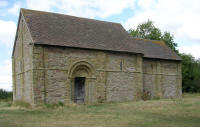 |
|
1.
Exterior of Heath Chapel, showing the only external Norman decoration |
|
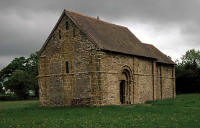 |
|
2.
Exterior showing the west end, and the three possible gallery lights
therein
|
|
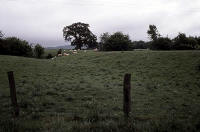 |
3.
This
photograph shows part of the earthworks belonging to a deserted
medieval village at Heath, near Clee St. Margaret in south Shropshire.
The surviving earthworks cover an area around 4 hectares. They include
at least five possible building platforms and a number of holloways.
Holloways are ancient tracks that have been worn into the landscape
through heavy use during the course of occupation at the settlement.
|
A chapel
[of Ease] was built in the 12th century and
was dependent in the mid 14th [century] on
Stoke St. Milborough church. (fn.
36) It had no separate advowson or endowment and was not licensed
for weddings until 1922.
This
mid 12th-century chapel, of no known dedication, is a 'perfect example
of a small Norman church'. It consists of a rectangular chancel and a
nave with south doorway, each of two bays .
. . The only
external decoration is on the doorway, where there are chevron mouldings
on the arch and hoodmould and incised abstract patterns on the capitals.Two small lights in the west gable presumably lit
an upper compartment or gallery within. Such a feature at the
west end may explain why the south doorway was sited so far east that
the middle buttress of the south wall is east of its northern
counterpart. A ledge over the chancel arch probably supported the nave
roof's eastern tiebeam. The chancel arch, of three plain orders, has
scalloped capitals. A plain rectangular recess in the chancel south wall
may represent a former piscina but has no drain hole. The cylindrical
tub font is plain but for shallow incised arcading round part of the
top; lines in a spandrel on the north side seem to form a face. The font
stood by 1852 on one square stone platform set diagonally upon another.
|
Quite alone in a field. The perfect example of
a rich little Norman chapel (of Stoke St
Milborough), impressively orderly in design. Nave and lower chancel. No
bell-cote. Broad, flat, full-height buttresses and continuous mid-height
string course. Tiny windows, three in west gable, one each in the middle
buttress of the W and E ends, and one per bay N and
S. S doorway under a broad arch on two orders of shafts. Decayed,
originally ornamented capitals. Chevron on the outer arch moulding, and
chevron on the hoodmould. Plain tympanum. The materials are mauve
sandstone rubble for the walling, friable yellow limestone for
dressings. Repaired 1912 on SPAB principles – see the tile ‘stitches’ –
by Basil Stallybrass.
Inside, the chancel has two orders of shafts
with scalloped capitals and double-stepped arch. Simple tie-beam roof,
perhaps of the C16.
FONT: Norman,
tub-shaped, with just a frieze of incised arches below the top.
[FITTINGS]: Pulpit, Reader’s desk, squire’s pew, box pews, all
probably C17. Another pew in the chancel made up of old including Perp.
part.
COMMUNION RAIL: Set
on feet round three sides of the altar table, in the Laudian way. Turned
balusters.
DOOR: The iron-work
looks mid C12, perhaps remade C19.
WALL PAINTINGS:
Traces of C12 masonry patterns, an unidentified C14 scheme on the
chancel E wall, and C15 subjects in the nave. On the S wall St George,
and above the chancel arch the Last Judgement, with the mouth of Hell at
the E end of the S wall. After the Reformation everything was whitewashed
over and in the C17 texts painted. They in turn are greatly faded.
[Source: Nicklaus Pevsner: Shropshire]
|
|
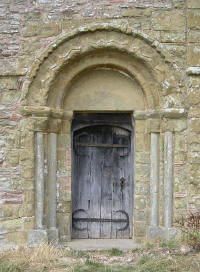 |
4.South
doorway: C12 round headed doorway of 2 orders. Chevron carved design
on hoodmould and outer order of arch, and roll moulding on inner.
Plain tympanum. Plain abaci with chamfered undersides. Crude flat
scroll capitals now mostly eroded. C19 restored grey stone shafts and
bases. Door is cross-boarded and has medieval iron hinges.
[From:
An Architectural
Account of the Churches of Shropshire: Cranage D H S: 1895-: 96; The
Buildings of England: Pevsner N: Shropshire: Harmondsworth, Middlesex:
1958-: 147; Klein P: A Guide to The Heath Chapel Shropshire:
Leominster: 1990]
|
In the 16th or 17th century the nave roof was
renewed, perhaps completely. A flat plaster ceiling was made in the
chancel. In chancel and nave medieval paintings were whitewashed over
and texts were painted, at least on the lower walls; they included the
Commandments and Creed in the nave, and were themselves later
whitewashed over. In the 17th century a rail was
placed on three sides of the communion table. A pew incorporating
medieval materials, including a beam from the former chancel screen and
a crude tulip shaped finial, was introduced on the south side of the
chancel, facing the pulpit; the chancel had three pews in 1793. (fn.
57) The pulpit is a 17th-century two-decker
in the north-east angle of the nave, lit by an original north window
enlarged in the 17th century to a square opening. Nave pews, some carved
to match the pulpit, were introduced at the same time.
|
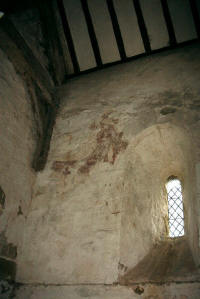 |
|
5.
Interior showing south wall and the free unsupported roof truss |
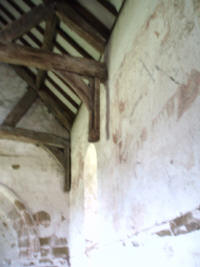 |
6.
Another view of the unsupported trusses and free-hanging wall supports
with no corbels or wall-plate to support them.
|
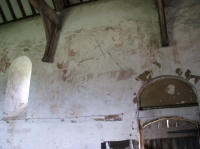 |
7.
This shows the same truss, totally unsupported and hanging sideways.
Note the remedial work required to these, as also to the wall
paintings.
|
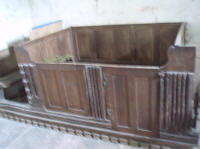 |
|
8. Family pew (possibly
Squire's or Parson's) |
|

|
|
|

|
|
|
|
|
SEARCH THIS SITE |
|
|
This
site has been constructed by, and remains the copyright of,
its authors,
Edwin and Sheila Macadam,
Shelwin, 30, Eynsham Road, Botley,
Oxford OX2 9BP
|
|
| ©
July 2001 -
|
|








